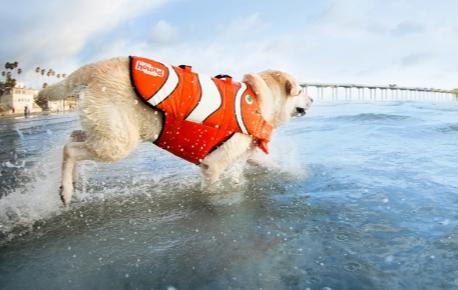
- posted: Jul. 16, 2019
Summer can be a great time to bond with your pet. But higher temperatures also mean higher risks for our furry companions - more injuries, more skin and ear infections, and a possibility of a heat stroke.
Pets do not sweat in the same way humans do and can easily become overheated. To avoid this problem and enjoy the summer season with your pet, here’re the tips to keep in mind.
1. Provide plenty of water and shade
Dehydration in dogs and cats is a real possibility during the summer, especially if your pet is the type to run and play outside for extended periods without drinking sufficient water. Signs of dehydration include:
- Loss of skin elasticity.
- Loss of appetite.
- Vomiting with or without diarrhea.
- Reduced energy levels and lethargy.
- Panting.
- Sunken, dry-looking eyes.
- Dry nose.
- Dry, sticky gums.
- Thick saliva.
To avoid this, give your active pet plenty of playtime breaks in the shade with access to fresh water. Make sure your pet always has access to fresh, clean water inside the house as well as when enjoying the outdoors.
Another good tip is to keep your pet in the shade as often as possible. While dogs and cats like to sunbathe, direct sunlight can overheat them (especially dogs) and lead to heat stroke.
2.Know the signs
Dogs and cats don’t sweat like we do. They drink water and pant to bring down their body temperature.
Watch for these possible symptoms of overheating:
- Panting which increases as heatstroke progresses
- Drooling, salivating
- Agitation, restlessness
- Very red or pale gums
- Bright red mucous membranes
- Increased heart rate
- Breathing distress
- Vomiting
- Diarrhea (possibly with blood)
If your pet shows signs of heat exhaustion, move them to a cool place, give them a drink of water, put a damp towel over their body, and get them to the vet asap. Do not place your pet in a cold bath/shower as the sudden change in temperatures can put your pet into shock.
3.Never leave your pet in the car
Most pets love riding in cars. But they wouldn’t enjoy being stuck in it when it heats up to over 100°F inside. You may think leaving your pet in a car for a few minutes is no big deal. However, it can take less than 10 minutes for our furry friends to develop heat stroke when inside of a hot vehicle.
Leaving your pets in cars not only dangerous to your pet, but it is also illegal in some areas that have specific “hot car” laws. In bright sunshine, your car acts like an oven, becoming much hotter inside than the outside air even. In fact, on a sunny 70°F day, your car can heat up to over 100°F within minutes. So, either take your pet with you or leave him or her at home. If you see a pet left alone in a car under dangerous conditions, take action immediately - try searching for the owner or even call the police.
4. Schedule your activities accordingly
If you have a dog, walk and exercise your furry friend in the early morning and late evening rather than during the day. Temperatures tend to be at their highest peak mid day. When outside, take breaks in the shade and always have water available.
5. Keep your dog's paws cool
Pets regulate their body temperatures from the bottom up. If you’re out in the sun together, try to keep your pet off of hot surfaces like cement and asphalt. Not only can it burn paws, but it can also increase body temperature and lead to overheating. It’s also not a good idea to drive around with your dog in the back of a truck – the hot metal can burn paws quickly.
When spraying your dog with water, make sure to spray the paws and stomach to cool them down quicker. If you are using a wet towel, it’s better to rub their paws and stomach as well.
If you can't walk your dog during the early and later hours of the day, boots are a good way to protect their paws. Another option would be to only walk on grassy areas rather than cement surfaces.
6. Keep parasites off
In summer, fleas, ticks, mosquitoes, and other parasites are practically everywhere. They can carry parasites and diseases that can put your pet at risk. Ask you vet for the appropriate medical prescriptions to keep your furry family member pest-free.
7. Consider a life vest
Some dogs enjoy cooling off in water. Like a pool, lake, or ocean. We recommend to be very careful when choosing where you let them enjoy this activity. No all dogs swim well, and even those that do, might not know how to get out of the pool. Also, strong currents and riptides can quickly sweep your pet out to sea.
If you decide to take your furry friend sailing or boating, be sure it wears a life vest in a bright color to stay visible and afloat in case of an accident. Always keep an eye on your furry companion when near water.
Office Hours
8:00 AM - 8:00 PM
9:00 AM - 2:00 PM
Closed
Location
2319 Lakeshore Rd W.
Oakville, ON L6L 1H2, Canada


